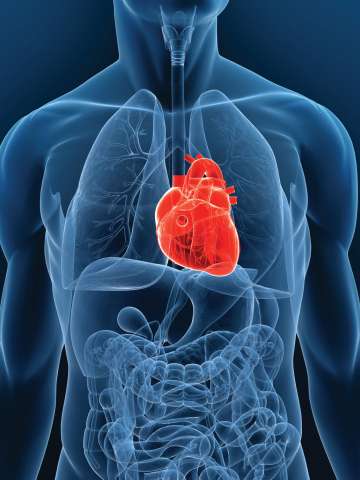Adult Congenital Heart Disease
UCLA Health provides comprehensive, team-based care for adults living with congenital heart defects. We lead one of the largest adult congenital heart disease centers in the country.

Why choose UCLA Health for adult congenital heart disease care?
An increasing number of people born with heart problems (congenital heart diseases) grow into adulthood. Yet they still require lifelong, specialized care. The Ahmanson/UCLA Adult Congenital Heart Disease Center, founded in 1980, was the first in the United States to focus exclusively on treating adults with congenital heart defects. Since then, it has grown into one of the largest facilities of its kind in the nation.
Highlights of our program include:
National recognition: Our program was among the first to earn accreditation as a Comprehensive Care Center by the Adult Congenital Heart Association. This designation highlights our commitment to providing holistic and leading-edge care.
Specialized services: Our center is also designated by the Marfan Foundation as a coordinated clinic for treatment of Marfan syndrome. This means we combine the expertise of every relevant specialist, including cardiologists, vascular surgeons, cardiothoracic surgeons, geneticists, orthopaedic surgeons, ophthalmologists and high-risk obstetricians, to care for people with congenital heart defects related to Marfan syndrome.
Highly trained experts: Our physicians treat patients from all over the state, country and world. We are specially trained in adult congenital heart disease (ACHD), with diverse expertise in areas such as echocardiography, cardiac catheterization, electrophysiology, pulmonary hypertension, cardiac imaging and complex CHD.
Research emphasis: Not only do our physicians provide exceptional clinical care, but they also conduct research to improve and discover new treatment options. We collaborated with Oregon Health Sciences to publish a landmark study about how COVID-19 affects adults with ACHD. We continually find and implement the best, most effective treatments, bringing you the most up-to-date options.
Our areas of care
Our ACHD center is both a clinical service location as well as a leading research and training facility. Our areas of care include:
Clinical care
The Ahmanson/UCLA Adult Congenital Heart Disease Center specializes in treating adults with congenital heart defects. Whether you need medication management or advanced surgical options, our team of experts can provide an effective treatment plan.
Research program
Our physicians research and study new treatments for ACHD. They prioritize studies that can quickly translate into care improvements, so you always receive leading-edge treatment. Eligible patients may have access to promising new therapies through participation in clinical trials.
Training program
We also are committed to training the next generation of physician leaders. Physician fellows in cardiology and pediatric cardiology may train at our center. This offers them real-life experience in ACHD treatment under careful supervision from a specialized physician.
Adolescent/Young Adult Transitional Care Program for Congenital Heart Disease
We collaborate with pediatric cardiologists to ensure that their patients smoothly transition to an adult care provider. We provide comprehensive assessments, individualized transition plans, education and counseling to teens, young adults and their caregivers. Learn more about the Adolescent Transitional Cardiac Care Program.
Types of congenital heart disease we treat
Congenital heart diseases are problems with the heart’s structure that are present at birth. Also called congenital heart defects, CHD is the most common type of congenital disorder.
CHD can range from mild to very severe. Thanks to modern advances in medicine, more children with CHD are growing into adulthood. In fact, experts estimate around 2 million adults in the U.S. have a congenital heart disease.
We treat adults with CHD and conditions associated with congenital heart disease, including:
Congenital heart diseases
Our specialists offer ongoing care for adults who were born with congenital heart diseases, such as:
Atrial septal defect (ASD): Babies are born with a hole in the wall (septum) between the heart’s two upper chambers (atria). It causes too much blood flow through the right side of the heart and lungs. A small hole may not cause any symptoms. A large ASD may lead to rapid heartbeats (palpitations), shortness of breath, fatigue or leg swelling. Over time, it can cause complications such as pulmonary hypertension, irregular heart rhythms and stroke.
Bicuspid aortic valve: The aortic valve has two valves instead of the typical three. The aortic valve controls blood flow from the heart to the aorta, the main artery that pumps blood throughout the body. A bicuspid valve may not close or open as it should, leading to impeded blood flow or blood leakage (regurgitation).
Hypoplastic left heart syndrome: The left side of the heart doesn’t form as it should. As a result, it can’t pump blood throughout the body.
Patent ductus arteriosus (PDA): The opening between the aorta and the pulmonary artery, which sends blood to the lungs, doesn’t close as it should. As a result, too much blood flows to the lungs. Small openings might not cause any symptoms. Large PDAs may cause symptoms such as rapid heartbeat, difficulty feeding, poor weight gain, heart murmurs or repeat respiratory infections.
Patent foramen ovale (PFO): PFO is a hole between the left and right upper heart chambers (atria) that is present in all developing fetuses. In most babies, the hole closes shortly after birth. In people with PFO, this hole doesn’t close as it should. PFOs often don’t cause any symptoms, but they may lead to migraines or complications such as stroke.
Pulmonary atresia: The pulmonary valve, which controls blood flow from the heart to the lungs, doesn’t form properly. As a result, it’s difficult for blood to get oxygen from the lungs.
Tetralogy of Fallot (TOF): This is a combination of four heart problems that often occur together and cause difficulty with blood flow. The defects include a ventricular septal defect (VSD), a narrowing of the pulmonary valve and artery, and a thick lower-right heart chamber (right ventricle). The aorta is also in the wrong position. Normally, it branches off the left ventricle. But in TOF, it lies in the middle of both ventricles and covers the VSD.
Tricuspid atresia: The tricuspid valve, which controls blood flow between the upper and lower right heart chambers, doesn’t form at all. Babies often also have an atrial septal defect or ventricular septal defect. Babies born with tricuspid atresia require surgery early in life to redirect and improve blood flow.
Ventricular septal defect (VSD): Babies are born with a hole in the wall (septum) between the heart’s two lower chambers (ventricles). If the hole is small, babies usually don’t experience symptoms. But a large VSD means the heart has to work harder to deliver oxygen to the body. Babies may experience symptoms such as rapid breathing, bluish tinted skin, poor weight gain and difficulty feeding.
Conditions associated with congenital heart disease
We also provide comprehensive, targeted treatment for disorders associated with congenital heart disease, including:
Eisenmenger syndrome: This rare condition causes a type of high blood pressure called pulmonary hypertension, which affects the lungs and right side of the heart. People with Eisenmenger syndrome usually have a congenital heart defect that wasn’t treated in early childhood. Symptoms typically develop around puberty and may include bluish skin, shortness of breath, fatigue or rounded fingers and toes (clubbing).
Long QT syndrome: In this heart rhythm disorder, the heart “recharges” for longer than usual between beats, leading to a fast or irregular heartbeat.
Marfan syndrome: This genetic condition affects the body’s connective tissues, often affecting the heart, blood vessels, eyes, joints and bones. Marfan syndrome may cause an enlarged aorta, which could lead to an aortic tear or rupture. Aortic enlargement can also cause problems with blood flow, resulting in a pounding heartbeat and shortness of breath during light activity.
Treatment for conditions related to congenital heart disease
Even if you have a heart defect that is repaired or treated in childhood, you’ll need lifelong follow-up care to prevent other health complications. Adults with CHD have a higher risk of irregular heart rhythms, heart infections and heart muscle weakness.
Our team treats all conditions and complications related to ACHD, including:
- Co-existing acquired heart disease
- Co-existing heart rhythm disorders (arrhythmias)
- Complications or after-effects of the Fontan procedure, a surgery performed in early childhood to correct congenital heart defects such as tricuspid atresia or hypoplastic left heart syndrome (HLHS)
- Hypertrophic cardiomyopathy, a thickened heart muscle
- Pregnancy and heart disease
- Pulmonary hypertension, increased blood pressure in the heart and lungs
Treatments we offer
Our team provides full-spectrum care to help adults manage congenital heart disease. Depending on your diagnosis and the severity of your symptoms, your treatment may include:
Cardiac monitoring: Patients may need routine imaging to ensure the heart is working properly. We may use echocardiograms (Echo) to evaluate the heart’s structures and blood flow. Or, we may use electrocardiograms (EKGs) to assess the heart’s electrical activity.
Medication: Some patients need medicines to control the side effects of a congenital heart disease. For example, we offer specialized drug treatments to manage pulmonary hypertension in people with Eisenmenger syndrome.
Catheter-based procedures: During these procedures, an interventional cardiologist or endovascular surgeon inserts a small tube called a catheter into a blood vessel and guides it to the heart. Then they place tools through the catheter to open narrowed valves, replace heart valves or close a hole in the septum. Doctors may also use interventional techniques to treat conditions associated with CHD. They may open blocked arteries or perform an ablation, which creates tiny scars in heart tissue to correct an irregular heart rhythm.
Open-heart surgery: Open-heart surgeries involve making a long incision down the center of the chest to open the breastbone (sternum) and access the heart. Adults with CHD may need coronary artery bypass graft (CABG) surgery, in which the heart surgeon creates a new route for blood to flow around a blocked artery.
Clinical trials: UCLA Health physicians continually research the newest treatment options and may offer investigational therapies to eligible patients. You may ask your provider if you qualify for treatment in a clinical trial.
Meet our team
Our ACHD treatment team includes some of the nation’s leading experts in the care of congenital heart disease. We actively research the newest treatments so that we always bring you leading-edge options. An entire team of highly experienced subspecialists cares for you.
Contact us
Call 310-825-9011 to request an appointment with a UCLA Health specialist in adult congenital heart disease.
Find your care
Our specialists provide a wide range of treatments, including clinical trial therapies. Call 310-825-9011 to learn more about adult congenital heart disease treatment.
Heart Walk 2025
Join us as we walk for the more than 2.5 million people living with congenital heart disease (CHD) across the country. Sat, Sep 6, 2025, Griffith Park - Park Center.
